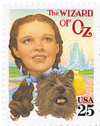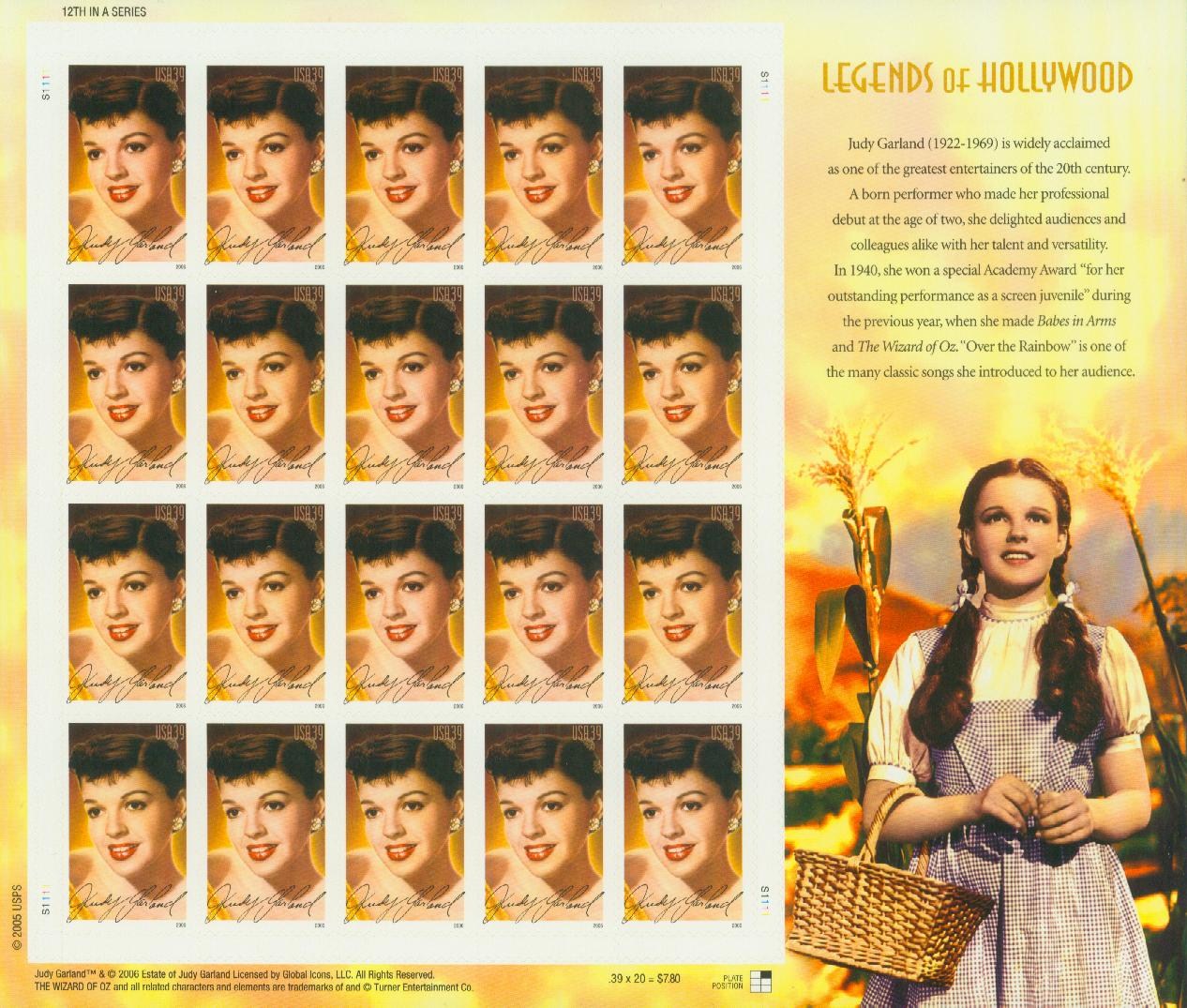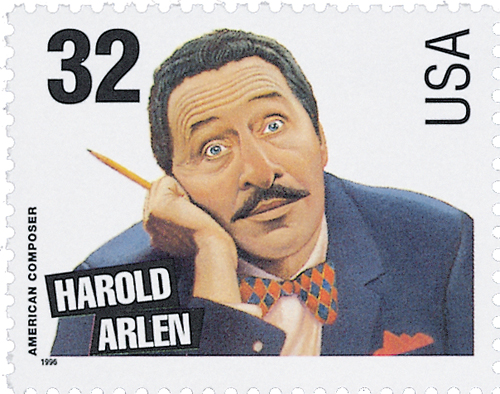
# 2445 - 1990 25c Classic Films: Wizard of Oz
US #2445
1990 Wizard of Oz
- Part of a Set of 4 Classic Films stamps
- Commemorates 50th anniversary of four Oscar-nominated films
- Celebrates the Golden Age of Hollywood
Stamp Category: Commemorative
Set: Classic Films
Value: 25¢, First-Class mail rate
First Day of Issue: March 23 1990
First Day City: Hollywood, California
Quantity Issued: 44,202,000
Printed by: American Bank Note Company
Printing Method: Photogravure
Format: Panes of 40, from printing cylinders of 160
Perforations: 11
Why the stamp was issued: This stamp is part of a block of four honoring classic films from Hollywood’s golden era. Each of the four films featured received Academy Award nominations in 1940.
About the stamp design: Each stamp resembles a miniature movie poster with bright, glossy colors. They picture the stars of each film, as well as the title and a scene from the movie in the background. Thomas Blackshear was chosen to do the artwork for the stamps. He used original movie posters and photographs from the films as inspiration.
First Day City: The First Day of Issue ceremony for the Classic Movie stamps took place at the Academy of Motion Pictures Arts and Sciences in Beverly Hills, California, though the postmark was Hollywood. This was the location of the 62nd Academy Awards celebration three days later.
Unusual fact about these stamps: The stamps were originally planned for issue in 1989, the 50th anniversary of release of these films. Difficulties with obtaining permission from the film company and families of the stars pictured delayed the stamps until 1990. This coincided with the Academy Awards ceremony for these films.
About the Set: Time magazine called 1939 the “year of genius and glitter” that was “the most memorable 12 months in the history of the American cinema.” All the films featured in this set were produced that year, and all were nominated for Academy Awards (or Oscars). The four movies chosen for the stamps were: The Wizard of Oz, Gone with the Wind, Beau Geste, and Stagecoach.
History the stamp represents:
The Wizard of Oz was based on a children’s book by L. Frank Baum. The film was notable for its use of Technicolor, a fairly new invention at the time. Its special effects were also ahead of their time. Judy Garland, the star of the show, won a special Academy Award as a “screen juvenile.” The film also took home the best song and best scoring awards. In 1956, The Wizard of Oz was first broadcast on television. It became a yearly favorite of American viewers.
Premiere Of The Wizard Of Oz
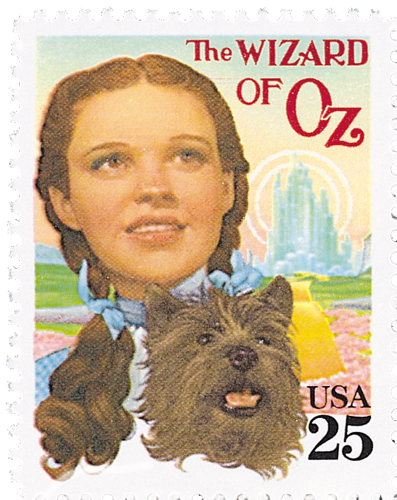
On August 15, 1939, The Wizard of Oz premiered at Grauman’s Chinese Theatre in Hollywood, California.
Film studio Metro-Goldwyn-Mayer (MGM) grew interested in producing a film version of The Wizard of Oz after Disney’s Snow White and the Seven Dwarfs proved that adaptations of children’s stories could be successful. MGM bought the rights in January 1938, after which the script was written and rewritten several times, to be completed that October.
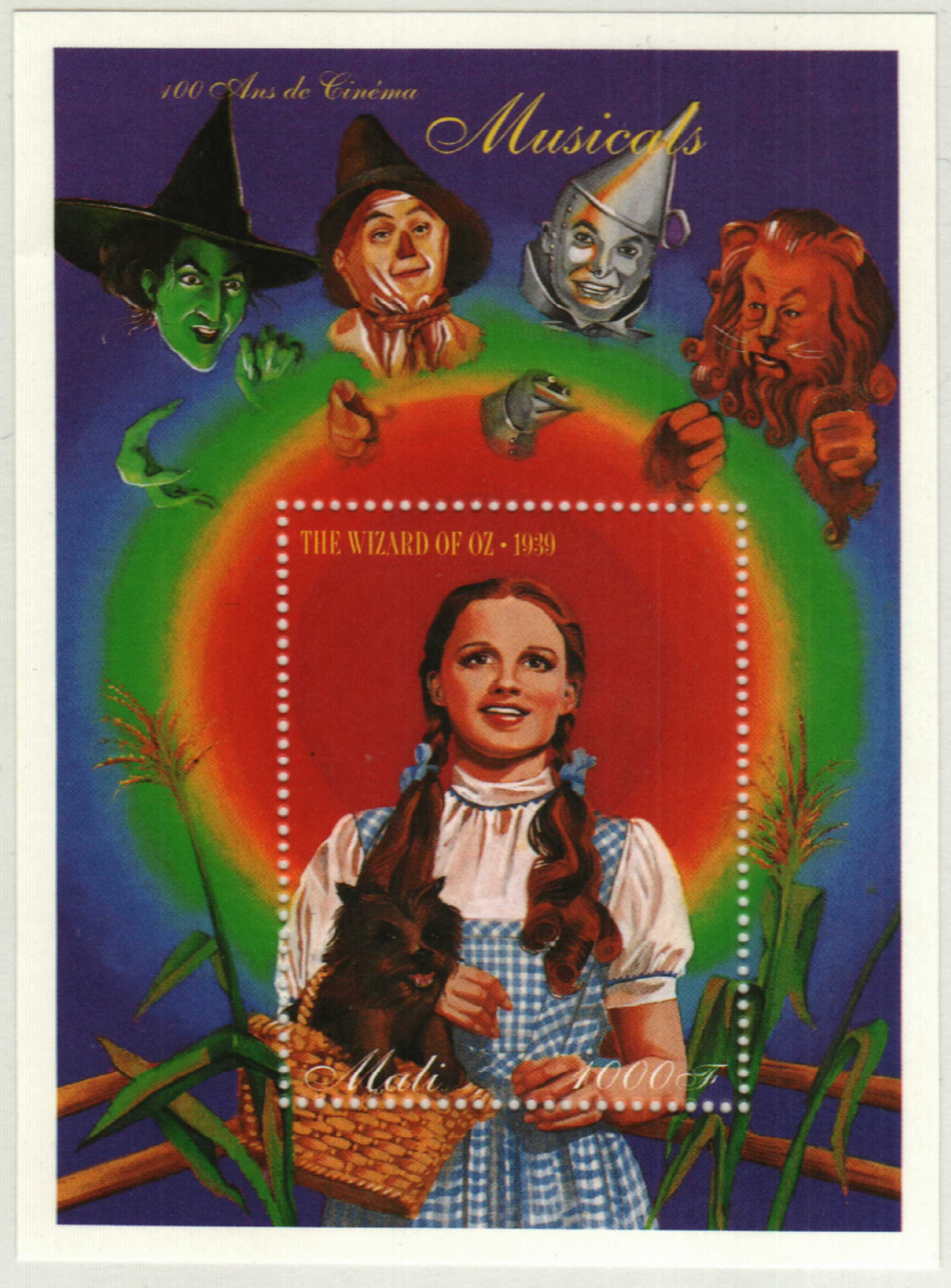
Among the actresses considered for the main role of Dorothy was reportedly Shirley Temple, though Judy Garland would eventually win the role. And originally, Ray Bolger was cast as the Tin Man and Buddy Ebsen as the Scarecrow. But Bolger had always wanted to play the Scarecrow and convinced the producer’s to switch their roles. (Ebsen later left the production after suffering an illness brought on by the silver makeup.) W.C. Fields was also considered to play the Wizard, but extensive debate over his fees led the studio to hire Frank Morgan instead.
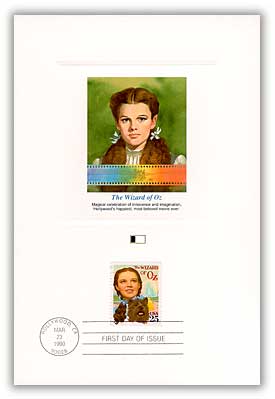
Filming for the movie began on October 13, 1938, in Culver City, California. The shooting schedule was grueling, with filming covering six days a week and lasting 16 hours a day. Plus the lights needed for the Technicolor filming heated the set to about 100 degrees. Filming ended on March 16, 1939. Though there would be reshoots through May.
The studio began showing test screenings in California as early as June 5. At the time the film was almost two hours long and they needed to cut some of it. They nearly cut out “Over the Rainbow” but producers and directors fought to keep it in. After three test previews in Wisconsin and Massachusetts, The Wizard of Oz officially premiered in Hollywood on August 15, 1939. This was followed by a New York City premiere two days later and then a national opening on August 25.
While the film proved to be popular with audiences, its high cost (about $2.8 million) meant it needed to make quite a bit of money to be a financial success. Its first release only made about $3 million, which was an impressive sum for the time, but wasn’t enough to be considered a success. That year The Wizard of Oz was nominated for six Academy Awards and would go on to win two – Best Original Song and Best Original Score.
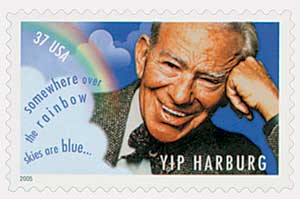
The Wizard of Oz enjoyed a resurgence a decade later when it was re-released in theaters in 1949. Then in 1956 CBS began playing it on television every year, helping it to become beloved to generations. Today its considered one of the greatest American films in history and is part of the National Film Registry and UNESCO’s Memory of the World Register.
US #2445
1990 Wizard of Oz
- Part of a Set of 4 Classic Films stamps
- Commemorates 50th anniversary of four Oscar-nominated films
- Celebrates the Golden Age of Hollywood
Stamp Category: Commemorative
Set: Classic Films
Value: 25¢, First-Class mail rate
First Day of Issue: March 23 1990
First Day City: Hollywood, California
Quantity Issued: 44,202,000
Printed by: American Bank Note Company
Printing Method: Photogravure
Format: Panes of 40, from printing cylinders of 160
Perforations: 11
Why the stamp was issued: This stamp is part of a block of four honoring classic films from Hollywood’s golden era. Each of the four films featured received Academy Award nominations in 1940.
About the stamp design: Each stamp resembles a miniature movie poster with bright, glossy colors. They picture the stars of each film, as well as the title and a scene from the movie in the background. Thomas Blackshear was chosen to do the artwork for the stamps. He used original movie posters and photographs from the films as inspiration.
First Day City: The First Day of Issue ceremony for the Classic Movie stamps took place at the Academy of Motion Pictures Arts and Sciences in Beverly Hills, California, though the postmark was Hollywood. This was the location of the 62nd Academy Awards celebration three days later.
Unusual fact about these stamps: The stamps were originally planned for issue in 1989, the 50th anniversary of release of these films. Difficulties with obtaining permission from the film company and families of the stars pictured delayed the stamps until 1990. This coincided with the Academy Awards ceremony for these films.
About the Set: Time magazine called 1939 the “year of genius and glitter” that was “the most memorable 12 months in the history of the American cinema.” All the films featured in this set were produced that year, and all were nominated for Academy Awards (or Oscars). The four movies chosen for the stamps were: The Wizard of Oz, Gone with the Wind, Beau Geste, and Stagecoach.
History the stamp represents:
The Wizard of Oz was based on a children’s book by L. Frank Baum. The film was notable for its use of Technicolor, a fairly new invention at the time. Its special effects were also ahead of their time. Judy Garland, the star of the show, won a special Academy Award as a “screen juvenile.” The film also took home the best song and best scoring awards. In 1956, The Wizard of Oz was first broadcast on television. It became a yearly favorite of American viewers.
Premiere Of The Wizard Of Oz

On August 15, 1939, The Wizard of Oz premiered at Grauman’s Chinese Theatre in Hollywood, California.
Film studio Metro-Goldwyn-Mayer (MGM) grew interested in producing a film version of The Wizard of Oz after Disney’s Snow White and the Seven Dwarfs proved that adaptations of children’s stories could be successful. MGM bought the rights in January 1938, after which the script was written and rewritten several times, to be completed that October.

Among the actresses considered for the main role of Dorothy was reportedly Shirley Temple, though Judy Garland would eventually win the role. And originally, Ray Bolger was cast as the Tin Man and Buddy Ebsen as the Scarecrow. But Bolger had always wanted to play the Scarecrow and convinced the producer’s to switch their roles. (Ebsen later left the production after suffering an illness brought on by the silver makeup.) W.C. Fields was also considered to play the Wizard, but extensive debate over his fees led the studio to hire Frank Morgan instead.

Filming for the movie began on October 13, 1938, in Culver City, California. The shooting schedule was grueling, with filming covering six days a week and lasting 16 hours a day. Plus the lights needed for the Technicolor filming heated the set to about 100 degrees. Filming ended on March 16, 1939. Though there would be reshoots through May.
The studio began showing test screenings in California as early as June 5. At the time the film was almost two hours long and they needed to cut some of it. They nearly cut out “Over the Rainbow” but producers and directors fought to keep it in. After three test previews in Wisconsin and Massachusetts, The Wizard of Oz officially premiered in Hollywood on August 15, 1939. This was followed by a New York City premiere two days later and then a national opening on August 25.
While the film proved to be popular with audiences, its high cost (about $2.8 million) meant it needed to make quite a bit of money to be a financial success. Its first release only made about $3 million, which was an impressive sum for the time, but wasn’t enough to be considered a success. That year The Wizard of Oz was nominated for six Academy Awards and would go on to win two – Best Original Song and Best Original Score.

The Wizard of Oz enjoyed a resurgence a decade later when it was re-released in theaters in 1949. Then in 1956 CBS began playing it on television every year, helping it to become beloved to generations. Today its considered one of the greatest American films in history and is part of the National Film Registry and UNESCO’s Memory of the World Register.



